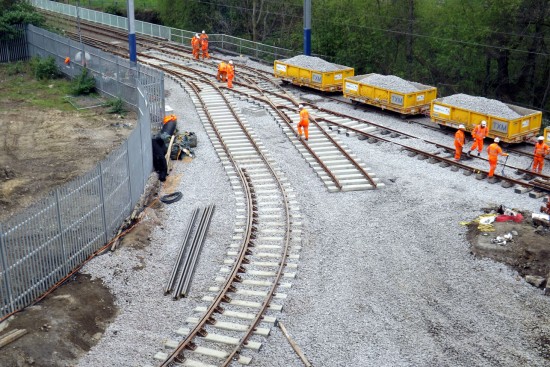The Easter weekend saw major work take place as preparations for the start of the Tram-Train pilot – likely to be 2018 – continue. Whereas a lot of the work which had taken place previously were on Network Rail metals and not as visible to regular tram travels this work saw the Supertram network joined with the Network Rail line at Tinsley Junction.
Whilst the work was undertaken Supertram services from the city centre were terminated at Meadowhall South/Tinsley with buses completing the journey into Meadowhall Interchange. There is no doubt that the pilot has been beset with problems and delays but with this work taking place – and other progress made on the line to Rotherham including the erection of overhead masts, the start of stop platforms being constructed and a bridge due to be removed and made higher to allow for electrification – it does finally look as if it won’t be too long before services can commence. Network Rail have been reluctant to give a revised date but it is widely expected that it will be at some point in 2018. When services begin there will be three an hour running to Rotherham Parkgate from Sheffield City Centre.

The junction is installed at Tinsley. The ballast train is on the Supertram line with the inbound line already joined up with the start of the outbound line also in place. (Photograph by Martin Hague)

Another aerial view of the junction. This image shows the track coming off the Network Rail line and the gap between the two lines.

Looking back towards Meadowhall South showing the proximity of the stop to the junction. (Photographs x2 by Stuart Cooke)

Work on the junction continues in this view from a different angle with the ballast train on the Supertram line. (Photographs x2 by Glyn Hill)

Another look at the work with the various different vehicles and pieces of equipment used to install the junction. (Photograph by Martin Hague)

The full ballast train seen to good effect. A Road-Rail vehicle was used to move the wagons – all of which were delivered by road.




Hmmm. Obviously no intention for any speed over the new connection other than very slow indeed with all those tight curves. No imagination again!! The trams will have to crawl from one line to the other. Ye gods!!
The radius seems needlessly tight. Not only will this require slow speeds but it will also make for a less comfortable journey and increase wear and tear. We know that tramways can have sharper curves than railways but there’s no need to brag about it!
I’ll give the planners the benefit of the doubt here, or may be I’m just giving them an excuse. Even though it’s taken 10 years to get this far, this is a trail scheme to test the viability of Tram-Train in the UK. This unnecessarily tight curve could be there to test running and wear on tram-trains.
I am guessing unless the tram trains are running to a set timetable where the junction would be set in advance it matters not because they will be waiting for access onto mainline anyway. It would be kind of pointless installing a high speed junction only to crawl along waiting for a signal at (either) end.
If they are running on Network Rail infrastructure they will have to be running to a timetable. Whether that timetable is published to the public is another matter. I suspect all the LRT systems have a working timetable for staff purposes, things would get a bit chaotic otherwise.